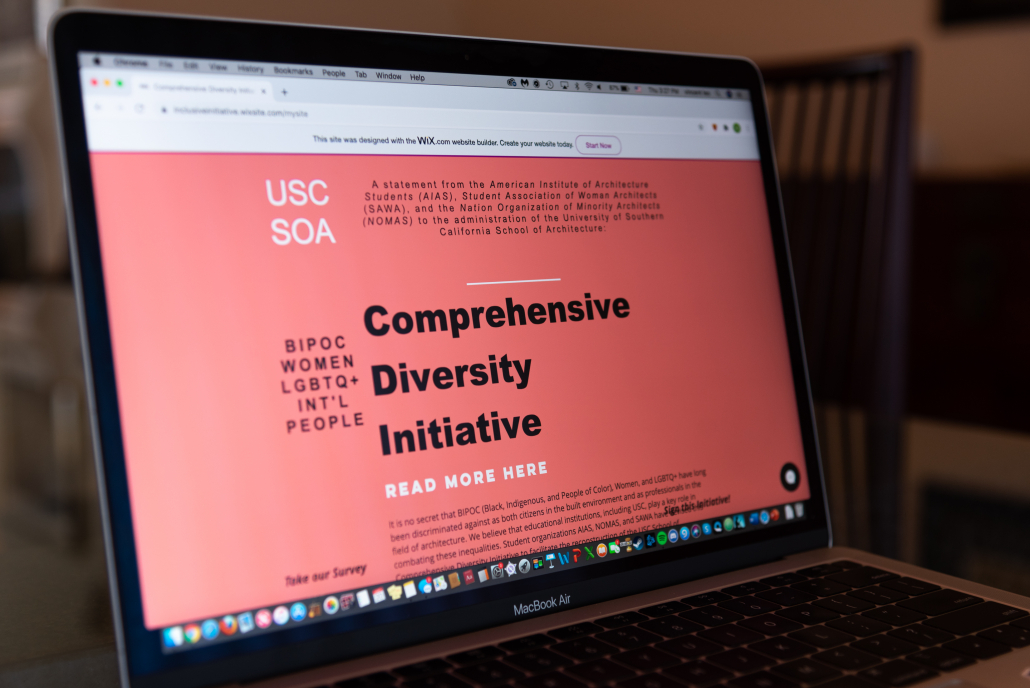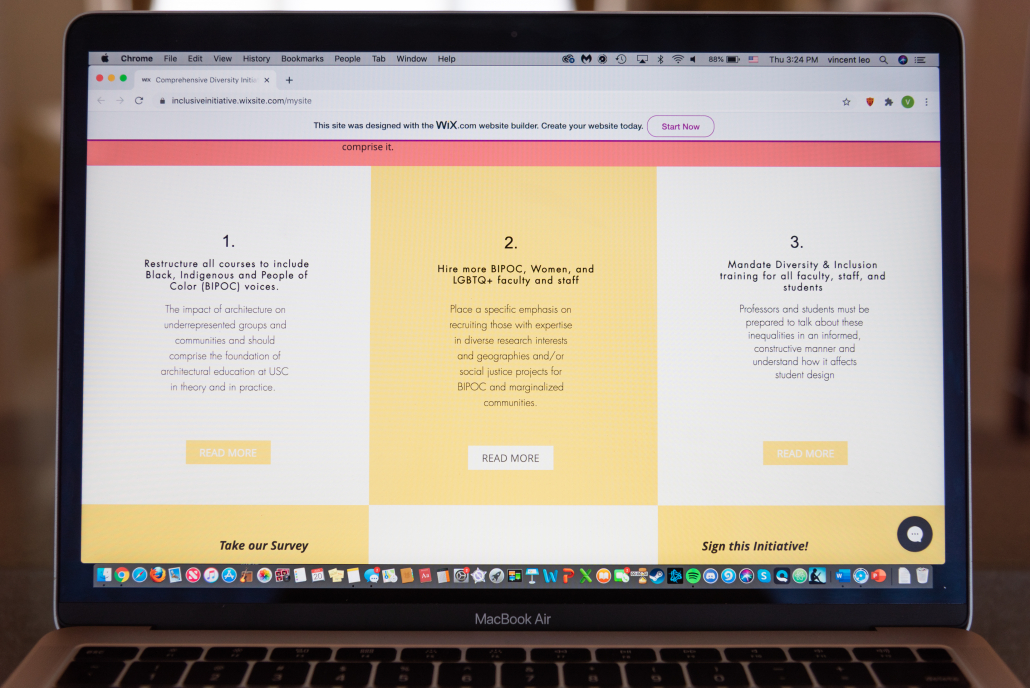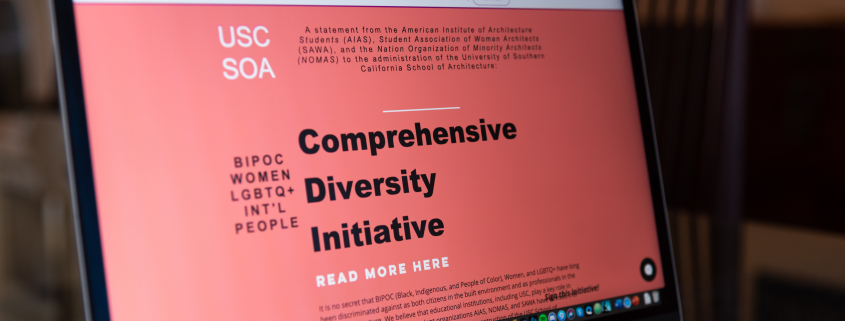Architecture students create demands to improve school’s inclusivity

This summer, five student leaders at the School of Architecture spent long nights meeting via Zoom drafting plans for discussions with professors and administration to make change within their school’s community. The students, who were either already friends or met through student leadership meetings with Dean Milton Curry, were inspired to take action by the increased activism around the country following the police killing of George Floyd.
“We were all just having the same thoughts and being like, ‘What can we do? How can we get involved? How can we make change, right now, within our communities that we’re involved in?’” said Abriannah Aiken, president of the Student Association of Women Architects.
The student leaders wrote a statement to their administration outlining a series of demands and solutions to increase diversity within the school. The June 30 statement was spearheaded by and released through student leaders of three campus organizations: the American Institute of Architecture Students, the National Organization of Minority Architects and the Student Association of Woman Architects.

“It sort of began as a discussion of the ways we, as student organization leaders, can actively combat racism against Black students and others who are discriminated against,” said Erin Light, one of the program coordinators for SAWA. “Then to use our positions to amplify the experiences of our peers.”
Light, along with four other student leaders, sent a letter to Curry and other school administrators June 22, explaining their goals and announcing a student survey they had created to gauge student opinion on representation and inclusiveness in the school’s curriculum and learning environment. Curry and Diversity Liaison Esther Margulies both responded to the letter later that day. Within the following days, Curry and Margulies announced and hosted an all-student forum on the topic of diversity June 29.
The survey received more than 130 responses from both undergraduate and graduate students, who were also asked to share any discriminatory experiences they may have encountered within the school. While the survey’s initial focus was on Black and Indigenous people and people of color, Light observed that discrimination within the school extended beyond just those marginalized groups.
“After reading so many really constructive responses, not only from BIPOC … but also from women, from LGBTQ people, from international students,” Light said. “We realized from there that it would almost be a disservice to our student body to not address discrimination in all forms.”
The survey received more than 130 responses from both undergraduate and graduate students, who were also asked to share any discriminatory experiences they may have encountered within the school. While the survey’s initial focus was on Black and Indigenous people and people of color, Light observed that discrimination within the school extended beyond just those marginalized groups.
“After reading so many really constructive responses, not only from BIPOC … but also from women, from LGBTQ people, from international students,” Light said. “We realized from there that it would almost be a disservice to our student body to not address discrimination in all forms.”
The survey’s results were then used to create the Comprehensive Diversity Initiative, a statement to the School of Architecture’s administration with specific ideas to facilitate more diversity within the school. The initiative comprises six main points, such as increased diversity among faculty and staff and improving accountability for toxic work environments.
Light said the group placed emphasis on “actionable things that [the] administration can do,” including providing more resources to students, especially in alleviating financial stress that Black and Latinx students reported struggling with.
To become an architect, students must devote significant time and money to schooling and to obtain a license, contributing to low diversity within the profession itself, Light said. In the United States, only 2% of licensed architects are Black.
“The major can be very expensive, so one of our [demands] was to get more funding for the software that’s required and more funding for materials that students have to use to build models,” Light said. “This semester, the administration will be paying for Adobe Creative Cloud and Rhino, which is a modeling software, which is going to be really great.”
The school’s administration has also been receptive and open to suggestions brought up by the initiative’s larger demands, such as the restructuring of curriculum to provide better representation of Black and Indigenous architects and architects of color, Light said. Although steps toward the restructuring have been made through meetings with the dean and professors, course curriculums have yet to be changed.
“We think [the curriculum] can be more inclusive of diverse architects and focusing on how we, as architects, can start thinking about [how] our designs are impacting the community that we’re designing in,” Aiken said. “We met with the dean and we proposed all of these things, and he was very much into it, and was very excited [about] working with us and working forward.”
The student leaders met again with Curry July 13 before presenting the initiative to faculty at a forum two days later. In the weeks following, the student leaders also held meetings with about half of the faculty who plan courses within the school.
At the time of publication, the school did not elaborate on the meeting they had with student leaders.
NOMAS executive board member Darwin Hu believes architecture students should be aware of their impact in creating spaces that are inclusive of all people and said it was a large guiding principle throughout the creation of the initiative.
“We have a lot of impact on the built environment that people will live in,” Hu said, “Within our education, we should be very aware of the communities and the histories behind the places we’re going into.”
Along with urging their peers to understand their influence in designing spaces, the student leaders hoped that the initiative could begin combatting the long-standing racism within their field.
“One of the first things that we were taught in architecture school is that it, as a discipline and as a career, [is one in] which designers are creating spaces to change how people feel when they’re in the space, how they interact with the space or how they interact with each other within the space,” NOMAS co-president Justin Wan said. “I feel like it’s ironic how there are so many problems that are ingrained in our major and in our discipline, and perhaps making a change will create a better learning environment.”
As student leaders continue to work with administration to fulfill more of their listed demands, they hope that the initiative will remain a lasting part of their respective clubs even after some of the founding members graduate this spring.
“It’s a constantly ongoing effort of listening to people, amplifying their voices and implementing that change,” Light said. “And we want to do that for years to come.”

